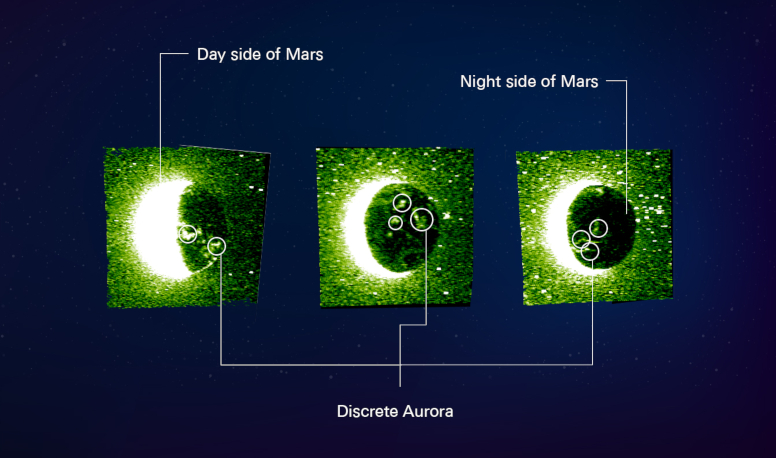Striking pictures showing a number of discreet auroras lit up by glowing atomic oxygen high up in the Martian night sky, have been captured by the UAE’s Hope probe, which arrived at the Red Planet earlier this year.
Known to exist, but never been imaged before at Mars, Hope used its Emirates Mars Ultraviolet Spectrometer instrument to capture the auroras at a wavelength of 103.4 nanometres; a region of the electromagnetic spectrum that has shorter wavelengths than visible light, but longer than X-ray radiation.
Although not perceptible to human vision, the auroras are created by a stream of electrically charged particles called ions sent from the Sun.
The ions are funnelled down into Mars' thin and wispy atmosphere by a patchy network of magnetic fields which are produced by huge deposits of magnetised minerals in the planetary crust.
The ions strike oxygen atoms causing a shimmering colourful glowing halo to dance across the skies.
These beacons of light that stand out against the dark nightside disk “provide an unprecedented perspective on these uniquely Martian aurorae”, the UAE said in a statement last week.
Billions of years ago, Mars once had a thicker, warmer atmosphere that allowed liquid water to flow on its surface.
It was kept in place by a global magnetic field, that like Earth was believed to have been generated by a dynamo effect, caused by molten liquid in its core revolving around a solid outer core, in the opposite direction of the planet’s rotation.
Then, for some reason, Mars lost much of its atmosphere – a process likely due to the smaller planet’s core cooling more quickly than Earth’s. It’s climate then transformed from one that might have supported life into the desiccated and frozen wasteland seen today.
In addition to these images, taken on 22 April, 23 April, the UAE has said it intends to release its first set of scientific data in September and make it openly available to scientists globally, so that it can contribute to humanity’s shared understanding of our second-closest planet.











